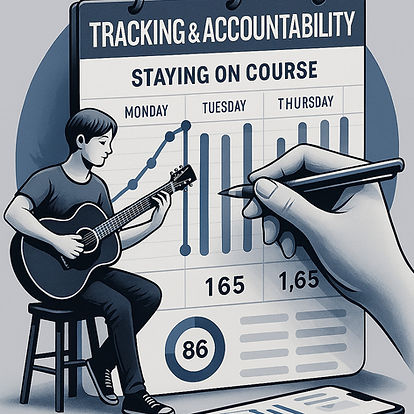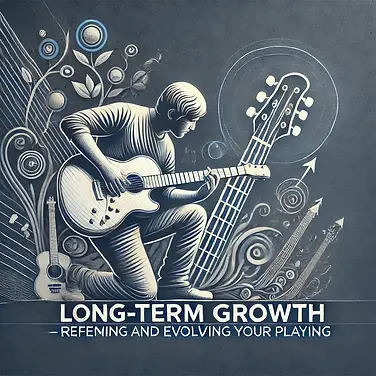
Granular Guitar Habits
Most people who start learning guitar give up. Not because they lack talent, but because they never build a habit of playing. They rely on motivation, which comes and goes, instead of creating a system that makes practice automatic.
Granular Guitar Habits is built around the idea that small, consistent improvements stack up over time—turning you into the guitarist you want to be.
Forget about setting big, overwhelming goals. Focus on the system. If you build the right habits, improvement is inevitable.
A Note on Inspiration
The ideas in Granular Guitar Habits are shaped by my own experience building a daily guitar practice over decades. However, one of the best books I’ve ever read on habit formation is Atomic Habits by James Clear.
While my approach to guitar was already built on small, repeatable improvements, Atomic Habits helped put many of those ideas into clear, structured principles. This guide adapts those habit-building strategies specifically for guitarists. If you're interested in habits in general, I highly recommend reading Atomic Habits for a deeper dive into these.
How This Works
This guide is broken into six key sections, each covering a different part of the habit-building process. Click on a section to dive in.
How This Links to My 66-Day Bootcamp
As I developed my own daily guitar practice, I began noticing patterns—small, repeatable actions that made progress feel natural. Later, when I read Atomic Habits, it gave language and structure to ideas I’d been using instinctively for years.
That book helped me refine my approach. In this guide, I’ve adapted those principles specifically for guitarists—and added personal insights where they hit hardest for me. You’ll find short notes in white text that highlight the ideas I’ve found most powerful.
These aren't long reads—but they’re worth your time. Reflect on which ideas resonate with you, and use them to build your own consistent, sustainable guitar habit. And if you're ready to commit, the 66-Day Bootcamp is where you put it into action.
1. Identity & Mindset – Becoming the Guitarist You Want to Be
Before you worry about technique, you need the right mindset. Your identity as a guitarist isn’t about talent—it’s about the habits you build.
-
[Chapter 1] Small Wins Add Up – Why tiny daily improvements lead to massive progress.
-
[Chapter 2] Identity Over Goals – Becoming the kind of guitarist who plays every day.
-
[Chapter 3] Making Practice Automatic – How guitar habits form and stick.
-
[Chapter 4] Awareness & Tracking – Noticing bad habits before they hold you back.


2. Building the Habit – Structuring Your Practice for Success
Most people fail because they don’t set up practice in a way that makes it effortless. This section is about making it obvious, attractive, and easy to play every day.
-
[Chapter 5] Cues & Triggers – Stacking habits to make playing second nature.
-
[Chapter 6] Shaping Your Environment – Making practice the easiest choice.
-
[Chapter 7] Breaking Bad Habits – Removing distractions that stop progress.
-
[Chapter 8] Making Practice Irresistible – Using dopamine and rewards to stay hooked.
3. Tracking & Accountability – Staying on Course
It’s easy to start strong, but how do you stick with it? This section covers tracking progress and holding yourself accountable.
-
[Chapter 9] Social Influence – Surrounding yourself with the right players.
-
[Chapter 10] Fixing Bad Habits – Replacing time-wasting habits with better ones.
-
[Chapter 11] Repetition Over Perfection – Why frequency matters more than duration.
-
[Chapter 12] Eliminating Friction – Setting up your practice space for effortless playing.


4. Motivation & Consistency – Keeping the Fire Alive
Motivation isn’t reliable. But structured challenge and progress are. This section keeps your playing fresh and engaging.
-
[Chapter 13] The 2-Minute Rule – Making practice impossible to skip.
-
[Chapter 14] Making Bad Habits Impossible – Structuring your environment for success.
-
[Chapter 15] Short-Term Rewards – Making practice satisfying right now.
-
[Chapter 16] Tracking Wins – Using progress streaks to stay committed.
5. Long-Term Growth – Refining and Evolving Your Playing
Once practice is a habit, how do you keep getting better? This section focuses on long-term mastery.
-
[Chapter 17] Accountability Systems – External pressure that keeps you playing.
-
[Chapter 18] Playing to Your Strengths – Developing a style that suits you.
-
[Chapter 19] The Sweet Spot of Challenge – Keeping practice hard enough to be engaging.
-
[Chapter 20] The Danger of Mindless Repetition – Staying sharp by reviewing habits.

How to Use This Guide
Start where you need the most help. If you struggle to stay consistent, focus on Building the Habit.
Take action. Reading won’t make you better—playing will. Try implementing one concept today.
Keep coming back. The best players constantly refine their process. Bookmark this page and use it as a reference.
Go to Chapter One here